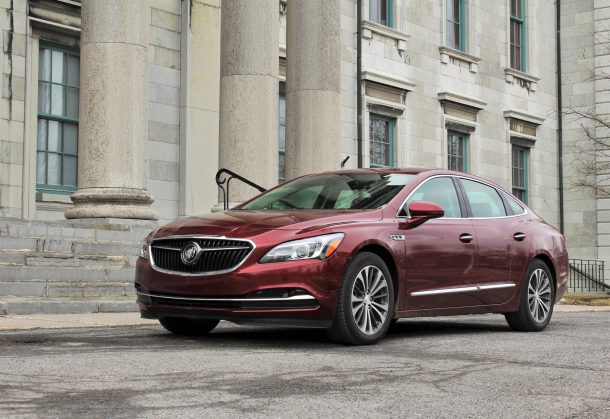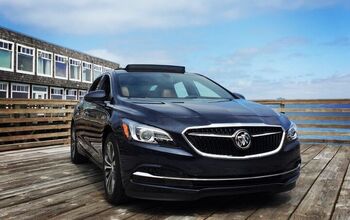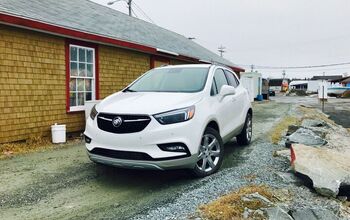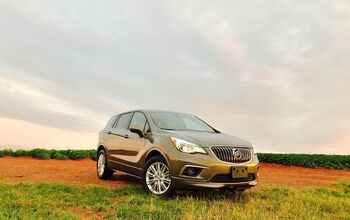2017 Buick LaCrosse Premium Review - Yesterday and Today

2017 Buick LaCrosse Premium
“You weren’t kidding when you said it was big,” she said, flashing me a smile.
“I never lie,” I said, lying.
She was, of course, talking about the 2017 Buick LaCrosse. Get your depraved minds out of the gutter.
I’d told my longtime friend I’d pick her up in a “big, red Buick,” and I certainly came through on that promise. And, as this friend — a former owner of a pinot-grigio-colored ’89 Skylark — settled herself comfortably into the sedan’s commodious front passenger seat, it seemed the LaCrosse had fulfilled its own obligations.
Sadly, it’s a relic in a rapidly shrinking segment. The last of a dying breed that once proliferated across the American landscape in numbers that would make pre-railway buffalo herds jealous. Yes, the LaCrosse is the last real Buick, even as it adopts the latest in safety and convenience features and fuel-saving technologies.
As a lover of every landau-topped barge from the golden age of motoring (or malaise, depending on who you ask), it was a somewhat bittersweet experience to spend time in the LaCrosse, as it does its job quite well. It’s a good soldier, and it surprises in many ways. But it can’t be a dog-and-Playskool-swallowing crossover, and that’s why it and the other holdouts in its segment are effectively doomed.
There’s a train a comin’, and the .45-70 Sharps rifles on board are firmly grasped by legions of singles, families and geriatrics who’ve come to love a taller ride height and spacious cargo hold.
Drastically restyled for the 2017 model year, Buick’s traditional full-sizer doesn’t disappoint dimension-wise. This is a big car, riding atop the P2XX platform it shares with the Chevrolet Impala, though 300-pounds lighter than before. Similar in length to its predecessor, the new LaCrosse grows nearly 3 inches in wheelbase, sprouted an extra 4 inches of legroom in the process, while shrinking in height by almost 2 inches.
All of this adds up to a car that appears much longer and wider than before, helped in that regard by a sculpted redesign echoing the beautiful Avenir concept of 2015.
I appreciated it. My friends appreciated it. The problem is, I didn’t see any passers-by eyeballing it. No double-takes in sight. No one tripping over themselves or walking into walls. Not that any of that mattered — you’ll see a similar disinterest in those walking by Toyota Corollas, Honda CR-Vs and Dodge Grand Caravans. Still, driving the LaCrosse, I couldn’t help but feel like something of a big shot.
Maybe it’s the size.
Big, long, plush sedans were, traditionally, the domain of important people, and the LaCrosse’s front seat sometimes felt more like a lounge, with my posture more of a languid, relaxed sprawl. Someone cue up the hi-fi! And maybe it’s also the effortlessness of everything. From the over-assisted steering that makes low-speed driving a one-finger feat (it tightens up in all the right conditions), the surprisingly precise turn-in and sprightly power, it’s almost impossible not to feel comfortable behind the wheel.
The LaCrosse’s 310 horsepower, direct-injection 3.6-liter V6 ensures passing is a breeze and an “old person’s car” needn’t be too boring an experience. Sure, the engine seems to prefer loping along at 1,250-1,500 rpm, barely raising its pulse, as the eight-speed automatic smoothly ushers you into a fuel-saving high gear as quickly as possible. But unlike some other overly endowed transmissions, this one doesn’t perturb the driver with endless hunting and unanticipated multi-cog downshifts. When you want the power, it’s there. Otherwise, no drama.
If long highway drives or lengthy stakeouts are your thing, both the soft ride and cushy-yet-supportive seats are unlikely to lead to regrets (though rear passengers might gripe about the optional panoramic sunroof’s ability to gobble headroom). Even the start-stop system knows to be unobtrusive, firing the mill up quickly enough to be ignored and holding off on engine shutdowns in most stop and go situations. Again, no drama.
The excitement begins when the LaCrosse chances upon a roadway rendered a battlefield by potholes, frost heaves and general neglect. Then, the Buick’s soft, floaty ride transitions into that of a storm-tossed lifeboat. I’d expect better road isolation from a vehicle with this price tag.
Unfortunately, this tester left out the one option that could’ve turned the LaCrosse from a rutted-road zero to hero. Buick offers an option package that’s sure to add tone to those doughy legs — HiPer Strut front suspension, continuously variable real-time damping and Sport Mode, plus 20-inch wheels — but you have to wonder what the take rate is for such a package. Are traditional full-size Buick buyers the type to go for it?
All-wheel drive, I should add, remains a northerner-friendly option, which this tester didn’t possess.
Inside the spacious cabin, at least when the road flattens out, serenity is your co-pilot. Road noise, even with 18-inch winter rubber below, failed to perturb my carefully cultivated state of Nuclear Family-era nirvana. On a trip home from the airport, a friend commented that his front legroom was the best he’d ever experienced — even with 3 inches of rearward seat travel left untapped. That comment stirred some curiosity in me, so I traded places. Imagine my shock when I discovered it was actually possible for a 6’4″ man to stretch his legs, knees locked, and not have his feet hit the firewall.
That’s spectacular. If I wasn’t so busy that week, I’d have a nap report for you.
Furnishings and switchgear — at a glance — seem to possess an acceptable level of fit and finish, while climate controls and the various steering wheel-mounted functions were easy to spot, easy to use. (I did wonder whether the rear driver’s side exterior window trim, which had noticeably lifted, was the fault of shoddy adhesive or a snagged jacket. For GM’s sake, I hope the latter, but doubts remain.)
Tasteful and helpful accent illumination abounds, from the footwells to stripes along the dash and even the gearshift. Kudos to Buick for the large, bright digital speedometer and nicely laid out gauges.
You don’t have to spend much time piloting this latter-day Roadmaster to appreciate its multi-generational ease of use. Whether Buick wants to admit it or not, customers buying this model probably chose it over an Impala, and aren’t likely to be of let’s-crowdsource-a-brewery age. Because of this, some modern features might rub traditional buyers the wrong way.
The worst offender is the monostable-style shift lever borrowed from the Cadillac XT5. While safety aids like pedestrian and collision detection are innocuous nice-to-haves, this feature represents the biggest clash of generations in this car.
This shifter is the type of kit that screams, “so modern it’s almost futuristic!” And while it makes for an clean and uncluttered console, it has also seen other automakers forced into roll-away recall mode (often out of an abundance of caution). While it’s easy to get used to, it isn’t foolproof. Say, for instance, that you’ve accidentally shuffled that thing down to “M” instead of “D”. (God knows no one will use the shift paddles — though they’re there, for some reason.) Tapping the shifter forward doesn’t get you back into drive. No, you’ll have to tap it twice, sending the car into neutral, before bumping it back down to drive. It’s a weird hiccup.
That said, drivers are presented with a glowing light and noticeable shifting sound when changing gears, so the result of the act isn’t a mystery. Elsewhere in the vehicle, handy items included rear seatback release handles in the generous trunk, as well as a rear window sunshade.
Perhaps more than most, I’m always interested in how a manufacturer’s fuel economy numbers stack up. We have a large vehicle and powerful engine here, so off I went on a two-hour road trip to a neighboring city, taking a secondary highway for scenery.
The result? Well, on the way, I discovered the robustness of the optional lane-holding function, which — sometimes forcefully — kept us on a straight and narrow heading. I also saw 35 miles per gallon staring me in the face after arriving at my destination — no tricks, no hypermiling, just straight driving. That beats the EPA highway rating by 4 mpg. Overall, mixed driving over the course of a week returned 25 mpg, which was right on the money. (Its EPA city rating sits at 21 mpg). That weight loss, attention to slipperiness, and the 3.6-liter’s start/stop and cylinder deactivation systems made fueling this modern-day land yacht less of a wallet punch than you’d imagine.
With some exceptions, Buick has crafted a modern automobile that taps the halcyon memories of yesteryear while refusing to be a technological laggard. Unfortunately, much to Buick’s dismay, the winds of consumer change are blowing against this spacious sedan with gale force. Though improved in seemingly every way over its predecessor, the public’s abandonment of most passenger car segments meant that the 2017 LaCrosse saw sliding sales from day one.
That’s a shame, as the LaCrosse shows what members of a once-prolific segment that’s now on life support can achieve. While on the pricey side for a near-premium front-wheel-drive sedan, this bountiful Buick deserves whatever attention and guarded accolades comes its way.
Too bad for Buick that the customer is always right.
[Images: Steph Willems/The Truth About Cars]

More by Steph Willems
Latest Car Reviews
Read moreLatest Product Reviews
Read moreRecent Comments
- Carrera 2014 Toyota Corolla with 192,000 miles bought new. Oil changes every 5,000 miles, 1 coolant flush, and a bunch of air filters and in cabin air filters, and wipers. On my 4th set of tires.Original brake pads ( manual transmission), original spark plugs. Nothing else...it's a Toyota. Did most of oil changes either free at Toyota or myself. Also 3 batteries.2022 Acura TLX A-Spec AWD 13,000 miles now but bought new.Two oil changes...2006 Hyundai Elantra gifted from a colleague with 318,000 when I got it, and 335,000 now. It needed some TLC. A set of cheap Chinese tires ($275), AC compressor, evaporator, expansion valve package ( $290) , two TYC headlights $120, one battery ( $95), two oil changes, air filters, Denso alternator ( $185), coolant, and labor for AC job ( $200).
- Mike-NB2 This is a mostly uninformed vote, but I'll go with the Mazda 3 too.I haven't driven a new Civic, so I can't say anything about it, but two weeks ago I had a 2023 Corolla as a rental. While I can understand why so many people buy these, I was surprised at how bad the CVT is. Many rentals I've driven have a CVT and while I know it has one and can tell, they aren't usually too bad. I'd never own a car with a CVT, but I can live with one as a rental. But the Corolla's CVT was terrible. It was like it screamed "CVT!" the whole time. On the highway with cruise control on, I could feel it adjusting to track the set speed. Passing on the highway (two-lane) was risky. The engine isn't under-powered, but the CVT makes it seem that way.A minor complaint is about the steering. It's waaaay over-assisted. At low speeds, it's like a 70s LTD with one-finger effort. Maybe that's deliberate though, given the Corolla's demographic.
- Mike-NB2 2019 Ranger - 30,000 miles / 50,000 km. Nothing but oil changes. Original tires are being replaced a week from Wednesday. (Not all that mileage is on the original A/S tires. I put dedicated winter rims/tires on it every winter.)2024 - Golf R - 1700 miles / 2800 km. Not really broken in yet. Nothing but gas in the tank.
- SaulTigh I've got a 2014 F150 with 87K on the clock and have spent exactly $4,180.77 in maintenance and repairs in that time. That's pretty hard to beat.Hard to say on my 2019 Mercedes, because I prepaid for three years of service (B,A,B) and am getting the last of those at the end of the month. Did just drop $1,700 on new Michelins for it at Tire Rack. Tires for the F150 late last year were under $700, so I'd say the Benz is roughly 2 to 3 times as pricy for anything over the Ford.I have the F150 serviced at a large independent shop, the Benz at the dealership.
- Bike Rather have a union negotiating my pay rises with inflation at the moment.









































Comments
Join the conversation
There is too much Hyundai Grandeur/Azera in this shape, right down to the flat windscreen, side profile and bodyside creasing. It looks dated. The Impala and XTS do the big American sedan look in a more convincing style.
I love the 2017 Buick LaCrosse and wish that I had room for another car! I drove this and it felt great. Well-described in this review. Disclaimer: I hate SUV's. Ugly sheetmetal clones blocking my traffic vision. Back to my story -I rented a 2016 Chevy Impala, decently optioned, to cart my Dad around on a short road trip and it was great, as well. Big, not too much, surprisingly light and agile feeling and nice understated styling. As it should be. My own car is a Chevy Corvette, so I'm not a Buick guy or land-yacht driver. Still, driving the LaCrosse/Impala cousins really does impart the feeling of being "important". It's different that zooming people in my Vette, this big car feels more like, "Yeah, it's me. I'm here and doing just FINE!" :)